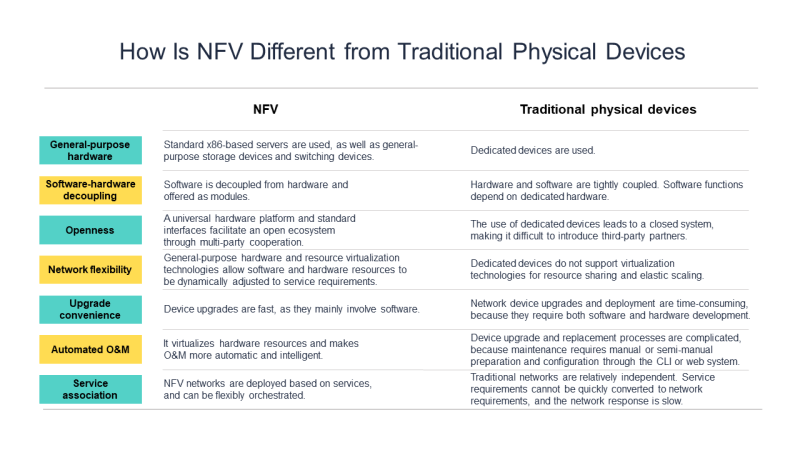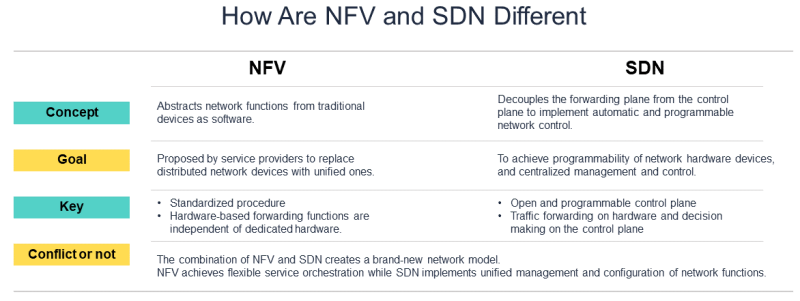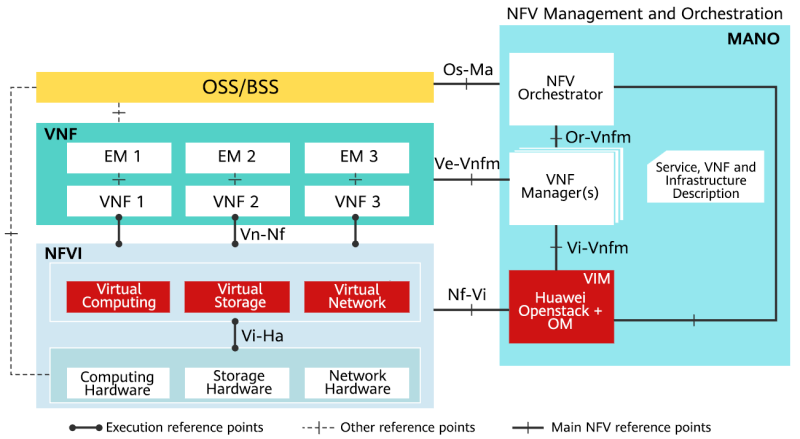What Is NFV?
Network functions virtualization (NFV) is a network architecture concept. Traditional network devices, such as routers, switches, firewalls, and load balancers, have their own hardware and software systems. Different from traditional devices, x86-based servers provide network functions after corresponding operating systems and software are installed. NFV uses the same architecture as that of x86-based servers. It decouples network functions from hardware, and instantiates them as independent software to run on general-purpose hardware.
NFV Architecture
The NFV architecture is proposed by the European Telecommunications Standards Institute (ETSI) and defines standards for NFV implementation. Different from traditional physical devices with tightly coupled software and hardware, NFV aims to implement various network functions on a general-purpose hardware device using standardized software. For this purpose, NFV calls for a standard. The NFV architecture consists of:
- Network functions virtualization infrastructure (NFVI)
Similar to a mobile phone operating system, NFVI provides infrastructure components to support software and container management platforms that are needed to run network applications on hardware.
- Virtual Network Function (VNF)
Similar to applications on mobile phones, VNFs are software applications that deliver network functions, such as forwarding services and IP configurations. Based on the standardized architecture of NFVI, VNFs can run independently of hardware.
- Management and Orchestration (MANO)
MANO provides the framework for managing NFVI and VNFs, facilitating service orchestration and device management of O&M personnel.

Standardized NFV architecture
OSS/BSS
The operations support system (OSS) and business support system (BSS) of service providers deliver management functions, and are not included in the NFV infrastructure. MANO and network elements (NEs) provide interfaces for communication with the OSS/BSS.
VNF
VNFs refer to virtual machines (VMs), as well as service NEs and network function software deployed on VMs.
NFVI
NFVI refers to the required hardware and software components that build the environment where VNFs are deployed. It comprises of:
- Hardware layer: The actual hardware resides at this layer, including devices that provide computing, network, and storage resources.
- Virtualization layer: At this layer, hardware resources are virtualized into virtual resources, including virtual computing, storage, and network resources. It is a main functional module defined in NFV.
MANO
MANO is responsible for unified management and orchestration of NFVI and VNFs. It is broken up into three functional blocks:
- Virtualized Infrastructure Manager (VIM), responsible for discovering resources, managing and allocating virtual resources, and handling faults.
- VNF Manager (VNFM), responsible for the lifecycle management of VNFs, including VNF instantiation, configuration, and termination.
- NFV orchestrator (NFVO), responsible for orchestrating and managing all software resources and network services on NFV networks.
Advantages of NFV over Traditional Physical Network Devices
The following figure compares NFV with traditional physical devices, which helps you better understand the characteristics of NFV.

Differences between NFV and traditional physical devices
Benefits of NFV
NFV applies to various network solutions, including SD-WAN, network slicing, and mobile edge computing. NFV decouples software functions from hardware and brings a number of benefits with the improvement of this standardized architecture:
- Flexible services
NFV offers the flexibility of running VNFs across different servers or moving them around as needed when demand changes. This accelerates the delivery of network functions and applications. For example, when a new network function needs testing, you can simply spin up a new VM to perform that function. Just as easily, the VM can be decommissioned when the function is no longer needed. This offers a convenient method for testing new functions.
- Less spending
With NFV, multiple virtualized network functions can run on a single hardware server. This means that less physical hardware is needed, which allows for resource consolidation to reduce costs in spaces and power needed for hardware. However, the investment is large in the initial phase of migration from traditional physical devices to NFV, and the return on investment (ROI) in the short term is not significantly higher than that of using traditional physical devices.
- Higher resource utilization efficiency
NFV eliminates the need for hardware changes when network requirements change. The basic network architecture can be quickly updated using software, avoiding physical device redundancy and migration.
- No vendor lock-in
By running VNFs on general-purpose hardware, NFV decouples network functions from dedicated hardware and eliminates vendor-lock due to specific functions, reducing network device maintenance costs.
NFV vs. SDN
What Is SDN?
With the rise in big data use for public service traffic, IT is becoming a consumer commodity and networks need to be flexible and secure enough. However, traditional network management approaches, such as configuring network devices through the command-line interface (CLI), do not mesh well with ever-changing needs in resources, services, and applications. Software-defined networking (SDN) provides a better fit in such situations.
SDN decouples the control plane from the forwarding plane in the network infrastructure and applies automation and programming to the control plane, enabling administrators to dynamically adjust network-wide traffic. Network control is centralized on SDN controllers, so that the entire network appears as a single logical network device. With the help of programmability, SDN controllers implement automated network configuration, control, protection, and resource adjustment.
How Are NFV and SDN Different?
The similarity between NFV and SDN is that they both abstract networks through virtualization.
However, they do so differently in separating functions and abstracting resources. SDN abstracts physical network resources, such as switches and routers, and moves decision making to the virtual network control plane. In this approach, the control plane decides where to send traffic, while the hardware directs and handles the traffic. By contrast, NFV aims to virtualize all physical network resources beneath a VM management program, which allows the network to grow without adding more devices.
NFV virtualizes physical networks with poor flexibility into software with strong flexibility. Through service orchestration, the entire network is like a program package, and various software and plug-ins are used for network planning. SDN decouples the control plane from the forwarding plane and centralizes the control and management of devices on SDN controllers. As such, SDN controllers can deliver instructions to devices in a unified manner to implement flexible service management.

How are NFV and SDN different
In the Huawei NFV architecture, FusionSphere is the virtualization software and also acts as the VIM. It virtualizes the compute, storage, and network resources, and manages, monitors, and optimizes these resources in a unified manner.

Huawei NFV architecture
Virtualization Layer
- Kernel-based Virtual Machine (KVM): virtualizes hardware resources. Huawei's FusionSphere adopts the KVM and enhances its performance and reliability.
- FusionStorage: is a piece of distributed storage software that has both storage and computing capabilities. It can be deployed on multiple general-purpose x86-based servers to combine the local disks on all the servers into a virtual storage resource pool to provide the block storage function.
- FusionNetwork: is a solution designed for traditional virtual switching to evolve to forward-thinking SDN. FusionNetwork uses Virtual Extensible LAN (VXLAN) layer 2 tunnel encapsulation technologies and Huawei SDN controllers to automatically deploy and configure SDN networks, control the SLA, and isolate multiple tenants with different levels.
VIM
- FusionSphere OpenStack: is an OpenStack enterprise edition that enhances and hardens OpenStack. It centrally schedules and manages virtual compute, storage, and network resources over unified interfaces. FusionSphere OpenStack also reduces the operating expense (OPEX) and provides high system security and reliability.
- FusionSphere OpenStack OM: is the O&M component of FusionSphere OpenStack. It monitors and manages hardware resources and the FusionSphere OpenStack software. In addition, it automatically provisions services, implements automated O&M, and provides a management portal for O&M engineers.
- Author: Li Yefan
- Updated on: 2021-09-30
- Views: 27177
- Average rating:






